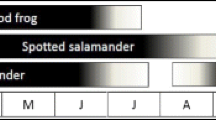Abstract
Vernal pools in northeastern North America are typically seasonal woodland pools that support breeding populations of amphibians and invertebrates dependent upon fishless environments for successful reproduction. A survey of 304 vernal pools in southern, central, and northern Maine, USA was conducted to assess pool physical characteristics, landscape setting, and presence of pool-breeding amphibians for the purpose of guiding potential pool conservation strategies. In particular, information on reproductive effort by pool-breeding amphibians was used to assess the statewide applicability of the Maine Natural Resources Protection Act’s proposed definition of Significant Vernal Pool, a category of Significant Wildlife Habitats that allows closer environmental review of proposed impacts to vernal pools. The results of our study show regional differences in pool characteristics and amphibian usage. Defining “significance” based on number of egg masses and diversity of vernal pool indicator species is a useful tool but should be considered in the context of such landscape characteristics as availability of suitable terrestrial habitat and distribution of other breeding habitats and wetlands.
Similar content being viewed by others
Literature Cited
Adam, M. D. and M. J. Lacki. 1993. Factors affecting amphibian use of road-rut ponds in Daniel Boone National Forest. Transactions of the Kentucky Academy of Sciences 54:13–16.
Brooks, R. T., J. Stone, and P. Lyons. 1998. An inventory of seasonal forest ponds on the Quabbin Reservoir watershed, Massachusetts. Northeastern Naturalist 5:219–230.
Burne, M. R. 2001. Massachusetts aerial photo survey of potential vernal pools. Natural Heritage and Endangered Species Program, Department of Fisheries and Wildlife, Westborough, MA, USA.
Calhoun, A. J. K. 2003. Maine citizen’s guide to locating and documenting vernal pools. Maine Audubon Society, Falmouth, ME, USA.
Calhoun, A. J. K. and P. K. deMaynadier. 2003. Forestry habitat management guidelines for vernal pool wildlife. United States Environmental Protection Agency, Boston, MA, USA.
Calhoun, A. J. K. and M. W. Klemens. 2002. Best development practices for conserving pool-breeding amphibians in residential and commercial developments in the northeastern U.S. Metropolitan Conservation Alliance, Wildlife Conservation Alliance. Bronx, NY, USA. MCA Technical Paper No. 5.
Colburn, E. A. 1997. Certified: a Citizen’s Step-by-Step Guide to Protecting Vernal Pools. Massachusetts Audubon Society, Lincoln, MA, USA.
Collins, J. P. and H. M. Wilbur. 1979. Breeding habits and habitats of the amphibians of the Edwin S. George Reserve, Michigan, with notes on the local distribution of fishes. Occasional Papers of the Museum of Zoology 686:1–34.
Cowardin, L. M., V. Carter, F. C. Golet, and E. T. LaRoe. 1979. Classification of wetlands and deepwater habitats of the United States. US Fish and Wildlife Service, Office of Biological Services, Washington, DC, USA. FWS/OBS-79/31.
deMaynadier, P. G. and M. L. Hunter, Jr. 1998. Effects of silvicultural edges on the distribution and abundance of amphibians in Maine. Conservation Biology 12:340–352.
deMaynadier, P. G. and M. L. Hunter, Jr. 1999. Forest canopy closure and juvenile emigration by pool-breeding amphibians in Maine. Journal of Wildlife Management 63:441–450.
DiMauro, D. and M. L. Hunter, Jr. 2002. Reproduction of amphibians in natural and anthropogenic temporary pools in managed forests. Forest Science 48:397–406.
Fahrig, L., J. H. Pedlar, S. E. Pope, P. D. Taylor, and J. F. Wegner. 1995. Effect of road traffic on amphibian density. Biological Conservation 73:177–182.
Gibbs, J. P. 1993. Importance of small wetlands for the persistence of local populations of wetland-associated animals. Wetlands 13: 25–31.
Gibbs, J. P. 2000. Wetland loss and biodiversity conservation. Conservation Biology 14:314–317.
Guerry, A. and M. L. Hunter Jr. 2002. Amphibian distributions in a landscape of forests and agriculture: An examination of landscape composition and configuration. Conservation Biology 16: 745–754.
Joyal, L. A., M. McCollough, and M. L. Hunter, Jr. 2001. Landscape ecology approaches to wetland species conservation: a case study of two turtle species in southern Maine. Conservation Biology 15: 1755–1762.
Kenney, L. P. 1991. Vernal pools in a suburban community. Master’s Thesis. Harvard University, Cambridge, MA, USA.
Marsh, D. M. and P. C. Trenham. 2001. Metapopulation dynamics and amphibian conservation. Conservation Biology 15:40–49.
Munger, J. C., M. Gerber, K. Madrid, M. A. Carroll, W. Petersen, and L. Heberger. 1998. U.S. National Wetland Inventory classifications as predictors of the occurrence of Columbia Spotted Frogs (Rana luteiventris) and Pacific Treefrogs (Hyla regilla). Conservation Biology 12:320–330.
Semlitsch, R. D. 1998. Biological delineation of terrestrial buffer zones for pond-breeding amphibians. Conservation Biology 12:1113–1119.
Semlitsch, R. D. and J. R. Bodie. 1998. Are small, isolated wetlands expendable? Conservation Biology 12:1129–1133.
Shoop, C. R. 1965. Orientation of Ambystoma maculatum: movements to and from breeding ponds. Science 149:558–559.
Snodgrass, J., M. J. Komoroski, A. L. Bryan Jr., and J. Burger. 2000. Relationships among isolated wetland size, hydroperiod, and amphibian species richness: implications for wetland regulation. Conservation Biology 14:414–419.
Stone, J. S. 1992. Vernal pools in Massachusetts: aerial photographic identification, biological and physiographic characteristics, and state certification criteria. Master’s Thesis. University of Massachusetts, Amherst, MA, USA.
Tappan, A. (ed.). 1997. Identification and Documentation of Vernal Pools in New Hampshire. New Hampshire Fish and Game Department, Concord, MA, USA.
Tiner, R. W. Jr. 1990. Use of high-altitude aerial photography for inventorying forested wetlands in the United States. Forest Ecology and Management 33/34:593–604.
Wilkinson, L., M. Hill, and E. Vang. 1992. Systat for windows Version 5. Systat Inc., Evanston, IL, USA.
Windmiller, B. S. 1990. The limitations of Massachusetts regulatory protection for temporary pool breeding amphibians. Master’s Thesis. Tufts University, Medford, MA, USA.
Windmiller, B. S. 1996. The pond, the forest, and the city: spotted salamander ecology and conservation in a human-dominated landscape. Ph. D. Dissertation. Tufts University, Medford, MA, USA.
Zar, J. H. 1984. Biostatistical Analysis. Prentice Hall, Englewood Cliffs, NJ, USA.
Author information
Authors and Affiliations
Corresponding author
Rights and permissions
About this article
Cite this article
Calhoun, A.J.K., Walls, T.E., Stockwell, S.S. et al. Evaluating vernal pools as a basis for conservation strategies: A maine case study. Wetlands 23, 70–81 (2003). https://doi.org/10.1672/0277-5212(2003)023[0070:EVPAAB]2.0.CO;2
Received:
Revised:
Accepted:
Issue Date:
DOI: https://doi.org/10.1672/0277-5212(2003)023[0070:EVPAAB]2.0.CO;2




